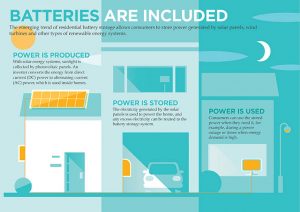In this case, “battery storage” does not refer to the drawer where you put the extra AA batteries for your flashlight! Instead, it refers to an emerging energy trend. Batteries and battery storage are evolving much like the way LED bulbs and lumens have transformed how we light our homes.
What’s driving battery storage?
Rooftop solar costs are dropping, and community solar options are increasing in popularity. In 2017, wind and solar electricity generation set a record by exceeding 10 percent of U.S. energy generation, according to the Energy Information Agency (EIA). News in the automotive world was dominated by announcements of major automakers stepping up production of electric vehicles (EVs), or in some cases, phasing out gas-powered engines altogether. As EVs gain popularity, charging stations are popping up in places of business and in other public spaces.
So, what does this all mean?
 Consumers are clearly looking for more renewable energy options. But intermittent power from wind and solar sources creates a need for energy storage. This is where batteries come into play. An increase in research and development in this energy sector is being driven by EVs and renewable energy trends. While the current focus is primarily on commercial applications, the impact on residential use will eventually follow. We can see improvements in the energy efficiency of lithium-ion batteries. For example, phone, computer and other types of batteries/charging stations are holding their charge longer and powering more energy-intense devices. There are hundreds of lithium-ion batteries, all of which have different capabilities and voltages.
Consumers are clearly looking for more renewable energy options. But intermittent power from wind and solar sources creates a need for energy storage. This is where batteries come into play. An increase in research and development in this energy sector is being driven by EVs and renewable energy trends. While the current focus is primarily on commercial applications, the impact on residential use will eventually follow. We can see improvements in the energy efficiency of lithium-ion batteries. For example, phone, computer and other types of batteries/charging stations are holding their charge longer and powering more energy-intense devices. There are hundreds of lithium-ion batteries, all of which have different capabilities and voltages.
Does better battery storage mean you can go ‘off the grid’ now?
While consumers using rooftop solar or other renewable energy sources have the most to gain, it’s not as easy as you would think to go off the grid completely. Powering the average consumer’s home, including HVAC systems, lights, appliances and the big screen TV, requires a tremendous amount of energy. Significant weather variation is another complicating factor. Going off the grid would require a solar array coupled with battery storage that is properly sized based on your energy consumption. Because battery storage technology is evolving and battery banks are not widely available, it is still not yet cost-effective for the average consumer to purchase.
However, the energy advisors at Orange County REMC are knowledgeable when it comes to energy efficiency and energy choices. Talk to us about your options, like time-of-use rate, energy audits and other programs that can help you save energy and money. If you decide to purchase an EV, let us know; your current electric service was designed and sized to meet consumers’ demands when the power lines were originally established and connected. We can also tell you about ideal charging times, like during off-peak hours, which helps conserve energy.
As our energy needs evolve, look to Orange County REMC for the information about energy trends and how to save energy.
Mark Belcher
Member Services Manager




